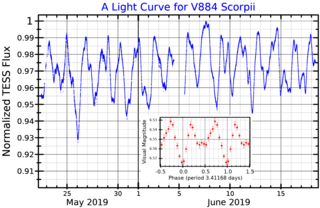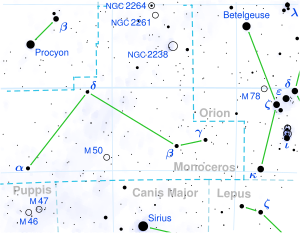
R Monocerotis, abbreviated R Mon, is a very young binary star system in the equatorial constellation of Monoceros. The apparent magnitude of R Mon varies between 10 and 12 and the spectral type is B8IIIe.

13 Vulpeculae is a blue giant with a stellar classification of class B9.5III in the northern constellation Vulpecula. It is visible to the naked eye as a faint, blue-white hued star with an apparent visual magnitude of 4.57 and it is approximately 339 light years away from the Sun based on parallax. The star is radiating 180 times the luminosity of the Sun from its photosphere at an effective temperature of 8,801 K.

R Canum Venaticorum is a Mira variable star in the constellation Canes Venatici. It ranges between magnitudes 6.5 and 12.9 over a period of approximately 329 days.
HD 225218 is a quadruple star system in the northern constellation of Andromeda. The primary component, HD 225218 A, is a giant star with a stellar classification of B9III, an apparent magnitude of 6.16, and is a candidate Lambda Boötis star. It has a fainter, magnitude 9.65 companion, HD 225218 B, at an angular separation of 5.2″ along a position angle of 171°. The primary itself has been identified as a binary star system through interferometry, with the two components separated by 0.165″. The pair, HD 225218 Aa and Ab, orbit each other with a period of about 70 years and an eccentricity of 0.515. Component B is likewise a spectroscopic binary.
HD 6114 is a visual binary star system in the northern constellation of Andromeda. With a combined apparent magnitude of 6.46, the star can only be seen with the naked eye by keen-eyed observers even on the best of nights. Based upon an annual parallax shift of 10.4 mas as seen from Earth's orbit, the system is located approximately 108 parsecs (350 ly) distant.

4U 1700-37 is one of the stronger binary X-ray sources in the sky, and is classified as a high-mass X-ray binary. It was discovered by the Uhuru satellite. The "4U" designation refers to the fourth Uhuru catalog.
4 Camelopardalis is a probable multiple star in the northern constellation of Camelopardalis, located 177 light years away from the Sun, based upon parallax. With a combined apparent visual magnitude of 5.29, it is visible to the naked eye as a faint, white-hued star. The pair have a relatively high proper motion, traversing the celestial sphere at an angular rate of 0.158″ per year. The system's proper motion makes it a candidate for membership in the IC 2391 supercluster. They are moving away from the Earth with a heliocentric radial velocity of 22.5 km/s.
HD 85390 is a star with an exoplanet companion in the southern constellation of Vela. It was given the proper name Natasha by Zambia during the 100th anniversary of the IAU. Natasha means "thank you" in many languages of Zambia. This star is too faint to be seen with the naked eye, having an apparent visual magnitude of 8.54. It is located at a distance of 109 light years from the Sun based on parallax, and is drifting further away with a radial velocity of 33 km/s.

1 Camelopardalis is a double star system in the constellation Camelopardalis. Its combined apparent magnitude is 5.56 and it is approximately 800 parsecs (2,600 ly) away.

c Puppis, also known as HD 63032 and HR 3017, is a spectroscopic binary star in the constellation Puppis. Its apparent magnitude is 3.61. Located around 347 parsecs (1,130 ly) distant, the primary is an orange-red bright giant or supergiant of spectral type K2.5Ib-IIa or K5IIa, while the secondary, discovered in 1983, is a blue main-sequence star of spectral type B9V. The system is the brightest member of the open cluster NGC 2451, over two magnitudes brighter than every other star in the cluster. As the turnoff point of the cluster is currently around B7, the parameters of the system fit with cluster membership.

KQ Puppis is a spectroscopic binary variable star in the constellation Puppis. A red supergiant star and a hot main sequence star orbit each other every 9,742 days. Its apparent magnitude varies between 4.82 and 5.17.
ADS 9731 is a star system that consists of six stars, located in the constellation of Corona Borealis. Four of the stars are visually separate in the sky, forming a visual star system, which was resolved using adaptive optics in 1995. Two of these stars were themselves found to be spectroscopic binaries in 1998, resulting in a total of six known stars in the system. It is one of very few multiple star systems known to have at least six members.

WR 20a is an eclipsing binary star belonging to or recently ejected from the young, massive cluster Westerlund 2. It was discovered in 2004 to be one of the most massive binary systems known, for which the masses of the components have been accurately measured.

DS Crucis is a variable star near the open cluster NGC 4755, which is also known as the Kappa Crucis Cluster or Jewel Box Cluster. It is in the constellation Crux.

HD 203030 is a single, yellow-orange hued star with a sub-stellar companion in the northern constellation of Vulpecula. The designation HD 203030 is from the Henry Draper Catalogue, which is based on spectral classifications made between 1911 and 1915 by Annie Jump Cannon and her co-workers, and was published between 1918 and 1924. This star is invisible to the naked eye, having an apparent visual magnitude of 8.45. It is located at a distance of 128 light years from the Sun based on parallax, and is drifting closer with a radial velocity of −17 km/s.

DH Cephei is a variable binary star system in the northern circumpolar constellation of Cepheus, positioned about two degrees to the east of the star system Delta Cephei. With an apparent visual magnitude of 8.61, it is too faint to be visible without a telescope. Based on parallax measurements, this system is located at a distance of approximately 9.6 kilolight-years from the Sun. At present it is moving closer to the Earth with a radial velocity of −33 km/s.
HD 44120 is a wide binary star system in the southern constellation of Pictor. Although visible to the naked eye, it is a challenge to view having an apparent visual magnitude of 6.44. The system is located at a distance of 118 light years from the Sun based on parallax, but it is drifting closer with a radial velocity of −2 km/s. It has an absolute magnitude of 3.57.

HD 193322 is a group of six stars which appear to be at least loosely bound into a system in the constellation Cygnus. The stars comprise the core of the young open cluster Collinder 419, which contains a total of 51 known stars. Another prominent member of the cluster is the eclipsing binary star V470 Cygni. The cluster lies at a distance of about 3500 light years and its stars are only a few million years old.
HD 155448 is a quintuple star system consisting of 5 young B-type stars. With an apparent magnitude of 8.72, it is too dim to be visible with the naked eye.

GK Tauri is a young T Tauri-type pre-main sequence star in the constellation of Taurus about 421 light years away, belonging to the Taurus Molecular Cloud.














